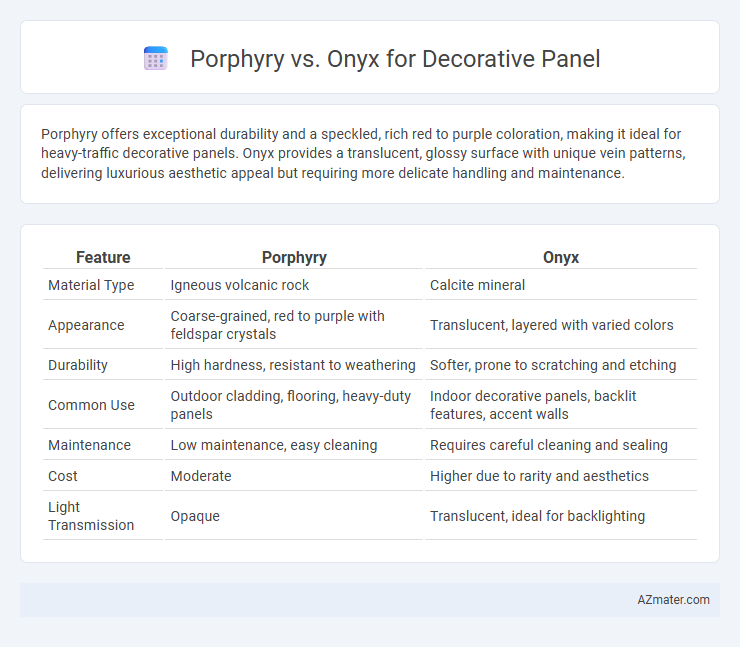Porphyry offers exceptional durability and a speckled, rich red to purple coloration, making it ideal for heavy-traffic decorative panels. Onyx provides a translucent, glossy surface with unique vein patterns, delivering luxurious aesthetic appeal but requiring more delicate handling and maintenance.
Table of Comparison
| Feature | Porphyry | Onyx |
|---|---|---|
| Material Type | Igneous volcanic rock | Calcite mineral |
| Appearance | Coarse-grained, red to purple with feldspar crystals | Translucent, layered with varied colors |
| Durability | High hardness, resistant to weathering | Softer, prone to scratching and etching |
| Common Use | Outdoor cladding, flooring, heavy-duty panels | Indoor decorative panels, backlit features, accent walls |
| Maintenance | Low maintenance, easy cleaning | Requires careful cleaning and sealing |
| Cost | Moderate | Higher due to rarity and aesthetics |
| Light Transmission | Opaque | Translucent, ideal for backlighting |
Introduction to Porphyry and Onyx
Porphyry is a durable igneous rock characterized by large, distinct crystals embedded in a fine-grained matrix, making it ideal for high-end decorative panels that require both strength and aesthetic appeal. Onyx, a strikingly translucent banded form of chalcedony, offers a luxurious and sophisticated look with its vibrant color variations and smooth texture, perfect for creating eye-catching interior designs. Both materials serve distinct decorative purposes, with porphyry favored for durability and onyx prized for its unique visual impact.
Geological Origins and Composition
Porphyry is an igneous rock characterized by large, well-formed crystals, typically feldspar, embedded in a fine-grained matrix, originating from volcanic processes deep within the Earth's crust. Onyx is a banded variety of chalcedony, a form of quartz, formed from silica deposits in cold water environments, leading to its distinctive parallel banding and translucency. The geological origins and mineral compositions of porphyry and onyx directly influence their texture, durability, and suitability for decorative panel applications.
Color Variations and Aesthetic Appeal
Porphyry offers rich, earthy tones with deep reds, purples, and browns, creating a warm, luxurious aesthetic that enhances decorative panels with natural stone elegance. Onyx displays a broader spectrum of translucent colors, including greens, whites, and golds, allowing light to pass through and producing a unique, glowing effect ideal for artistic and dramatic interior designs. The choice between Porphyry and Onyx for decorative panels depends on the desired interplay of color vibrancy and light transmission to achieve a specific aesthetic impact.
Durability and Maintenance Requirements
Porphyry offers exceptional durability due to its high resistance to scratches and weathering, making it ideal for decorative panels in both indoor and outdoor settings. Onyx, while visually striking with its translucent and unique veining, is softer and more prone to scratching and staining, requiring careful sealing and regular maintenance to preserve its appearance. Porphyry's low porosity reduces maintenance efforts, whereas onyx demands frequent cleaning and protective measures to maintain its luxurious look.
Cost and Availability Comparison
Porphyry, a durable igneous rock with unique red and purple hues, generally commands a higher price due to its rarity and complex quarrying process compared to Onyx, which is more widely available and often sourced from large deposits in countries like Turkey and Iran. Onyx panels, prized for their translucent appearance and variety of colors, tend to be more affordable and accessible, making them a popular choice for decorative applications where budget flexibility is important. Both materials offer distinct aesthetic qualities, but the cost and availability often influence the selection of Porphyry or Onyx for decorative panels in commercial and residential projects.
Suitability for Indoor and Outdoor Use
Porphyry offers exceptional durability and resistance to weathering, making it highly suitable for outdoor decorative panels exposed to harsh environmental conditions. Onyx, with its translucent and delicate nature, excels in indoor applications where it can be backlit and protected from moisture and temperature fluctuations. Both materials provide unique aesthetic appeal, but porphyry's hardness and low porosity make it the preferred choice for exterior use, while onyx is favored for luxurious indoor settings.
Installation Techniques and Challenges
Porphyry panels require precise anchoring and specialized cutting tools due to their hardness and brittle nature, making installation more labor-intensive compared to onyx. Onyx panels demand meticulous handling and reinforcement with backing materials like fiberglass or resin to prevent cracking during installation because of their translucency and fragility. Both materials necessitate skilled labor, but porphyry installation poses greater challenges in achieving seamless joints, while onyx requires careful lighting integration for optimal aesthetic effects.
Environmental Impact and Sustainability
Porphyry is a natural volcanic igneous rock known for its durability and minimal environmental impact due to its low energy-intensive extraction and processing methods. Onyx, a sedimentary stone composed primarily of calcite or aragonite, requires more energy for quarrying and processing, contributing to higher carbon emissions compared to porphyry. Porphyry's longevity and resistance to weathering enhance its sustainability for decorative panels, reducing the need for frequent replacement and conserving resources over time.
Popular Applications in Decorative Panels
Porphyry and Onyx are popular choices for decorative panels due to their unique aesthetic qualities and durability. Porphyry's coarse-grained texture and deep red or purple hues make it ideal for bold architectural statements and exterior cladding, offering a timeless, natural stone appearance. Onyx, known for its translucency and striking vein patterns, is favored in interior applications like feature walls and backlit panels, creating elegant and visually captivating designs.
Choosing Between Porphyry and Onyx: Key Considerations
Porphyry offers exceptional durability and resistance to wear, making it ideal for high-traffic decorative panels, while onyx provides a striking translucency and vibrant color palette for more elegant and visually impactful spaces. Consider the installation environment, maintenance requirements, and budget constraints, as porphyry's hardness demands specialized tools, whereas onyx is more fragile and requires careful upkeep. The choice hinges on balancing longevity with aesthetic appeal, ensuring that the selected material complements the design vision and functional needs of the project.

Infographic: Porphyry vs Onyx for Decorative Panel
 azmater.com
azmater.com